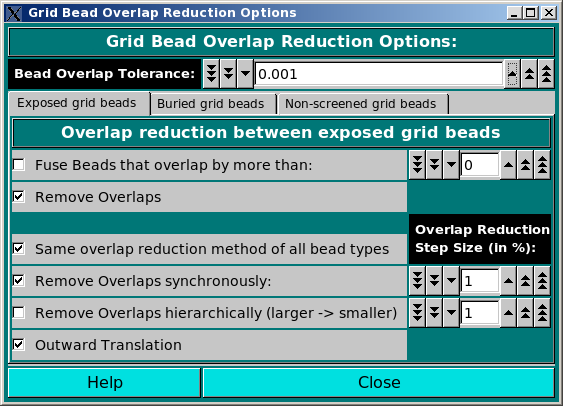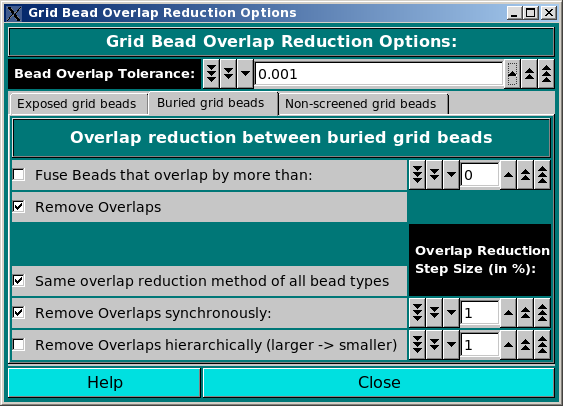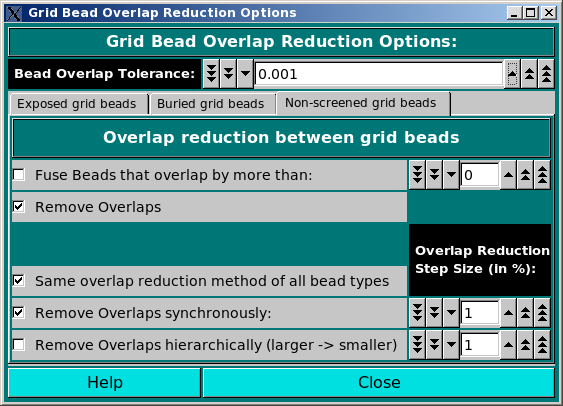
 |
Manual |
In this Module, you set the rules for removing the overlaps between the beads
generated in the first stage of the bead model building process. This operation is
mandatory for a correct computation of the hydrodynamic properties of
the bead model because the hydrodynamic interaction tensor used is valid for
non-overlapping spheres of different radii (Garcia de la Torre and
Bloomfield, Q. Rev. Biophys. 14:81-139, 1981; Spotorno et al., Eur. J. Biophys.
25:373-384, 26:417, 1997).
For Grid (AtoB)-type bead models, three different panels are available. The
first two, Exposed grid beads and Buried grid beads, operate when the
the Enable ASA screening function in the SOMO Grid Function Options (AtoB)
module is selected. The third panel, Non-screened grid beads, is operative when
the Enable ASA screening function in the SOMO Grid Function Options (AtoB)
module is not selected. In this case, ALL the beads are initially classified as
buried and then subdivided between buried and exposed at the end of the process by the ASAB1
routine.
Exposed grid beads:
 |
This Panel operates when the the Enable ASA screening function in the SOMO Grid
Function Options (AtoB) module is selected. The first checkbox in this panel,
Fuse Beads that overlap by more than:, activates
a "fusion" process between beads that overlap by more than the threshold set in
the corresponding field (default: 70%). A new bead is created with a volume equal to the
sum of the two original beads, and positioned in the center of gravity (cog) between the two beads.
The fusion process is a hierarchical procedure in which the couple with the biggest overlap
exceeding the threshold is treated first, and the ensemble is re-screened after each fusion. This
procedure was created for the SoMo-type bead models, and is not usually needed for
Grid (AtoB)-type bead models (default: inactive).
The second checkbox, Remove Overlaps, dictates if the whole procedure is active. It should be disallowed only for testing purposes or if the model is not used for hydrodynamic computations (default: active). Two alternative methods can then be selected to remove the remaining overlaps not exceeding the fusion threshold: Remove Overlaps synchronously and Remove Overlaps hierarchically (larger -> smaller). An Overlap Reduction Step Size (in %) field controls the finesse in this stage, by setting the step size (in % of the involved radii) used to remove the overlaps (default: 1%). The Same overlap reduction method for all bead types checkbox allow to automatically set the chosen procedure for all bead types (default: active). Furthermore, if this checkbox and the Automatically set suffix checkbox in the main panel are both selected, either the "hi" or "sy" symbol is added to the Bead Model Suffix field in the main panel. |
|
In the Remove Overlaps synchronously procedure, the radii of all beads having an overlap
are reduced by the selected % value in each step, and the ensemble is then
re-screened; beads no longer having an overlap are dropped from the list. If the
Outward Translation checkbox is selected, the beads centers are also moved
outwardly by the same amount along a line connecting them with the cog of the
molecule. The synchronous procedure is time-consuming, especially when
large structures are analyzed. The quality of the models appears to be higher
than that of models generated with the hierarchical procedure (more uniform bead sizes,
less space between beads), and there's a small effect also in the calculation of the rotational
diffusion and of the intrinsic viscosity, which appears to be linked to the volume correction
through the number of beads classified as exposed by the ASA re-check routine (default: active).
In the Remove Overlaps hierarchically (larger -> smaller), the biggest overlap between a couple of beads is first removed by proportionally reducing their radii. If the Outward Translation checkbox is selected, the beads centers are also moved outwardly along a line connecting them with the cog of the molecule. The minimal amount of translation and radius reduction leading to overlap removal is computed by solving a set of equations. If the Outward Translation is active, the couple is removed from the list and whole set is re-screened for overlaps after each overlap is removed, otherwise the couple is just removed from the list and the next one is treated. The Outward Translation was devised to maintain as much as possible the original surface of the molecule, which would otherwise shrink when the overlaps are eliminated by reducing the beads' radii (default: active). |
Buried grid beads:
 |
Overlaps between the Grid (AtoB)-type models buried beads are removed in this stage
when the the Enable ASA screening function in the SOMO Grid
Function Options (AtoB) module is selected. As in the previous Panel, there is
a Fuse Beads that overlap by more than: checkbox, whose use is however NOT recommended.
Again, the second checkbox, Remove Overlaps, dictates if the whole procedure is active.
It should be disallowed only for testing purposes, or if the model is not
used for hydrodynamic computations (default: active).
Only the two alternative options, Remove Overlaps synchronously and Remove Overlaps hierarchically (larger -> smaller) are present in this stage. They are controlled by the Overlap Reduction Step Size (in %) field, and have been fully described in the Exposed grid beads Panel (default: hierarchical). The Same overlap reduction method for all bead types checkbox allow to automatically set the chosen procedure for all bead types (default: active). |
Non-screened grid beads:
 |
This panel controls the overlap removal procedure for models build with the Grid (AtoB)
routine when he Enable ASA screening function in the SOMO Grid Function Options (AtoB) module is not selected. In this case, all the beads are initially
classified as buried, and the overlaps between them are removed in this stage. The ASA re-check routine
will then reclassify the beads between exposed and buried.
As in the previous two Panels, there is a Fuse Beads that overlap by more than: checkbox, whose use has not yet been fully tested, and thus is presently NOT recommended. Again, the second checkbox, Remove Overlaps, dictates if the whole procedure is active. It should be disallowed only for testing purposes, or if the model is not used for hydrodynamic computations (default: active). Only the two alternative options, Remove Overlaps synchronously and Remove Overlaps hierarchically (larger -> smaller) are present in this stage. They are controlled by the Overlap Reduction Step Size (in %) field, and have been fully described in the Exposed side chain beads Panel (default: hierarchical). The Same overlap reduction method for all bead types checkbox allow to automatically set the chosen procedure for all bead types (default: active). Furthermore, if this checkbox and the Automatically set suffix checkbox in the main panel are both selected, either the "hi" or "sy" symbol is added to the Bead Model Suffix field in the main panel. |
This document is part of the UltraScan Software Documentation
distribution.
Copyright © notice.
The latest version of this document can always be found at:
http://www.ultrascan.uthscsa.edu
Last modified on January 27, 2010.